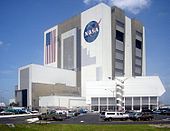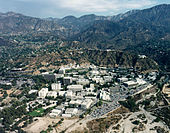- NASA facilities
-
- See also: NASA - Facilities
NASA Headquarters in Washington, DC provides overall guidance and direction to the agency.[1] NASA's Shared Services center is located on the grounds of the John C. Stennis Space Center, near Bay St. Louis, Mississippi.[2] Some facilities serve more than one application for historic or administrative reasons. NASA has used or supported various observatories and telescopes, and an example of this is the NASA Infrared Telescope Facility.
Facilities
John F. Kennedy Space Center (KSC), is one of the best known NASA facilities. It has been the launch site for every United States human space flight since 1968. Although such flights are currently on pause, KSC continues to manage and operate unmanned rocket launch facilities for America's civilian space program from three pads at the adjoining Cape Canaveral Air Force Station. Its iconic Vehicle Assembly Building (VAB) is the fourth-largest structure in the world by volume[3] and was the largest when completed in 1965.[4] Located on Merritt Island, Florida, the center is north-northwest of Cape Canaveral on the Atlantic Ocean, midway between Miami and Jacksonville on Florida's Space Coast. A total of 13,100 people worked at the center as of 2011. Approximately 2,100 are employees of the federal government; the rest are contractors.[5]
Jet Propulsion Laboratory (JPL) was together with ABMA one of the agencies behind Explorer 1, the first American space mission and also together with ABMA one of the first agencies to become a part of NASA. It is located in the San Gabriel Valley area of Los Angeles County, California. The facility is headquartered in the city of Pasadena [6] on the border of La Cañada Flintridge and Pasadena. JPL is managed by the nearby California Institute of Technology (Caltech). The Laboratory's primary function is the construction and operation of robotic planetary spacecraft, though it also conducts Earth-orbit and astronomy missions. It is also responsible for operating NASA's Deep Space Network.
George C. Marshall Space Flight Center (MSFC) is the place where the Saturn 5 rocket and Spacelab were developed. It is one of the largest center of NASA. Marshall is today the agency's lead center for Space Shuttle propulsion and its external tank; payloads and related crew training; International Space Station (ISS) design and assembly; together with computers, networks, and information management. Located on the Redstone Arsenal near Huntsville, Alabama, MSFC is named in honor of General George Marshall.
Canberra Deep Space Communication Complex (CDSCC) is a ground station that is located in Australia at Tidbinbilla outside Canberra. The complex is part of the Deep Space Network run by JPL. It is commonly referred to as the Tidbinbilla Deep Space Tracking Station and was officially opened on 19 March 1965. The station is separated from Canberra by the Coolamon Ridge, Urambi Hills and Bullen Range that help shield the city's radio frequency (RF) noise from the dishes.
Ames Research Center (ARC) was founded on December 20, 1939 as a NACA laboratory, and became part of NASA in 1958, as part of the turnover from NACA. The center was named after Joseph Sweetman Ames, a founding member of the NACA. ARC is one of NASA’s 10 major field centers and is located in California's Silicon Valley. Historically, Ames was founded to do wind-tunnel research on the aerodynamics of propeller-driven aircraft; however, it has expanded its role to doing research and technology in aeronautics, spaceflight, and information technology. It provides leadership in astrobiology, small satellites, robotic lunar exploration, intelligent/adaptive systems and thermal protection.
Langley Research Center (LaRC) is the oldest of NASA's field centers, located in Hampton, Virginia, United States. LaRC focuses primarily on aeronautical research, though the Apollo lunar lander was flight-tested at the facility and a number of high-profile space missions have been planned and designed on-site. Established in 1917 by the National Advisory Committee for Aeronautics, the Center currently devotes two-thirds of its programs to aeronautics, and the rest to space. LaRC researchers use more than 40 wind tunnels to study improved aircraft and spacecraft safety, performance, and efficiency. Between 1958 and 1963, when NASA started Project Mercury, LaRC served as the main office of the Space Task Group, with the office being transferred to the Manned Spacecraft Center (now the Lyndon B. Johnson Space Center) in Houston in 1962–63.
Lyndon B. Johnson Space Center (JSC) is the National Aeronautics and Space Administration's center for human spaceflight training, research and flight control. The center consists of a complex of 100 buildings constructed on 1,620 acres (656 ha) in Houston, Texas, USA.[7] Johnson Space Center is home to the United States astronaut corps and is responsible for training astronauts from both the U.S. and its international partners. It is often popularly referred to by its central function during missions, "Mission Control". The center grew out of the Space Task Group formed soon after the creation of NASA to co-ordinate the US manned spaceflight program. A new facility was constructed on land donated by Rice University and opened in 1963. On February 19, 1973, the center was renamed in honor of the late U.S. president and Texas native, Lyndon B. Johnson.[8][9] JSC is one of ten major NASA field centers.
List of facilities
- Communication and telescope facilities
- Deep Space Network (DSN) stations
- NASA Infrared Telescope Facility, Hawaii
- Near Earth Network (NEN) Terminals
- Poker Flat Research Range, Fairbanks North Star Borough, Alaska
- Space Network (SN) Ground Terminals
- Guam Remote Ground Terminal, Guam
- Construction and launch facilities
- John F. Kennedy Space Center, Florida
- Lyndon B. Johnson Space Center, Houston, Texas
- George C. Marshall Space Flight Center, Huntsville, Alabama
- Michoud Assembly Facility, New Orleans, Louisiana
- Wallops Flight Facility, Wallops Island, Virginia
- White Sands Test Facility, Las Cruces, New Mexico
- Research centers
- Ames Research Center, Moffett Federal Airfield, Mountain View, California
- Goddard Institute for Space Studies, New York City
- Goddard Space Flight Center, Greenbelt, Maryland
- Jet Propulsion Laboratory, California Institute of Technology, Pasadena, California
- John H. Glenn Research Center at Lewis Field, Cleveland, Ohio
- Langley Research Center, Hampton, Virginia
- Test facilities
- Ames Research Center, Moffett Federal Airfield, Mountain View, California
- Dryden Flight Research Center, Edwards Air Force Base, Los Angeles County, California
- Glenn Research Center, Plum Brook Station, Sandusky, Ohio
- Independent Verification and Validation Facility, Fairmont, West Virginia
- John C. Stennis Space Center, near Bay St. Louis, Mississippi
- Langley Research Center, Hampton, Virginia
- White Sands Complex, New Mexico
References
- ^ Shouse, Mary (July 9, 2009). "Welcome to NASA Headquarters". http://www.nasa.gov/centers/hq/home/index.html. Retrieved July 15, 2009.
- ^ Dubuisson, Rebecca (July 19, 2007). "NASA Shared Services Center Background". http://www.nssc.nasa.gov/main/background.htm. Retrieved July 15, 2009.
- ^ Kristie, K. (11 June 2009). "The Largest Buildings in the World". Quazen. "k-kristie.quazen.com/arts/architecture/the-largest-buildings-in-the-world"
- ^ "Senate". Congressional Record: 17598. September 8, 2004.
- ^ Dean, James (17 March 2011). "NASA budget woes leads to layoffs". Federal Times. http://www.federaltimes.com/article/20110317/AGENCY01/103170305/. Retrieved 21 August 2011.
- ^ http://www.jpl.nasa.gov/about_JPL/maps.cfm
- ^ NASA. "Lyndon B. Johnson Space Center". http://www.sti.nasa.gov/tto/spinoff1997/ar5.html. Retrieved 2008-08-27.
- ^ "Houston Space Center Is Named for Johnson". The New York Times: p. 19. February 20, 1973. http://select.nytimes.com/gst/abstract.html?res=F20A16FA39551A7493C2AB1789D85F478785F9.
- ^ Nixon, Richard M. (February 19, 1973). "50 - Statement About Signing a Bill Designating the Manned Spacecraft Center in Houston, Texas, as the Lyndon B. Johnson Space Center". http://www.presidency.ucsb.edu/ws/index.php?pid=4109#axzz1RbWN5hpf. Retrieved July 9, 2011.
Categories:
Wikimedia Foundation. 2010.







